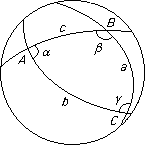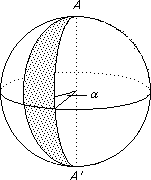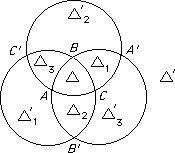Course MT3818 Topics in Geometry
Elliptic geometry
Recall that one model for the Real projective plane is the unit sphere S2 with opposite points identified.
On this model we will take "straight lines" (the shortest routes between points) to be great circles (the intersection of the sphere with planes through the centre).
We may then measure distance and angle and we can then look at the elements of PGL(3, R) which preserve his distance. This is a group PO(3) which is in fact the quotient group of O(3) by the scalar matrices. (In fact, since the only scalars in O(3) are ±I it is isomorphic to SO(3)).
This geometry then satisfies all Euclid's postulates except the 5th. Since any two "straight lines" meet there are no parallels.
This geometry is called Elliptic geometry and is a non-Euclidean geometry.
Some properties
- All lines have the same finite length π.
- The area of the elliptic plane is 2π.
- The sum of the angles of a triangle is always > π.
In fact one has the following theorem (due to the French mathematician Albert Girard (1595 to 1632) who proved the result for spherical triangles).
Girard's theorem
The sum of the angles of a triangle - π is the area of the triangle.

Proof
Take the triangle to be a spherical triangle lying in one hemisphere.
 The lines b and c meet in antipodal points A and A' and they define a lune with area 2α.
The lines b and c meet in antipodal points A and A' and they define a lune with area 2α.
 We get a picture as on the right of the sphere divided into 8 pieces with Δ' the antipodal triangle to Δ and Δ ∪ Δ1 the above lune, etc.
We get a picture as on the right of the sphere divided into 8 pieces with Δ' the antipodal triangle to Δ and Δ ∪ Δ1 the above lune, etc.
The area Δ = area Δ', Δ1 = Δ'1,etc.
Then Δ + Δ1 = area of the lune = 2α
and Δ + Δ2 = 2β
and Δ + Δ1 = 2γ
Also 2Δ + 2Δ1 + 2Δ2 + 2Δ3 = 4π ⇒ 2Δ = 2α + 2β + 2γ - 2π as required.

JOC March 2003

 The lines b and c meet in antipodal points A and A' and they define a lune with area 2α.
The lines b and c meet in antipodal points A and A' and they define a lune with area 2α. We get a picture as on the right of the sphere divided into 8 pieces with Δ' the antipodal triangle to Δ and Δ ∪ Δ1 the above lune, etc.
We get a picture as on the right of the sphere divided into 8 pieces with Δ' the antipodal triangle to Δ and Δ ∪ Δ1 the above lune, etc. 